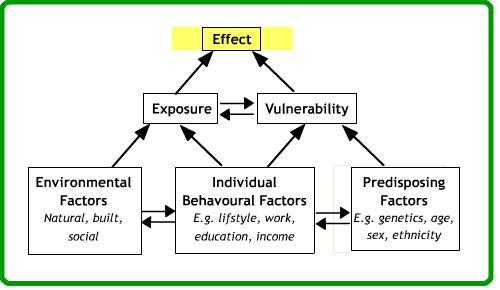3.3 Health event data
Health events may include vaccinations, hospital admissions, diagnoses, and mortality – indeed any event concerning an individual’s health or their interaction with the healthcare system. Data concerning such events form the basis of health applications of GIS and so it is important to understand the principles underlying such data.

It should be borne in mind that different types of health event are inter-related. Thus, an individual who has already contracted HIV/AIDS is at greater risk of developing tuberculosis. Similarly, an individual who is obese or who suffers from hypertension or diabetes is at greater risk of coronary heart disease.
Of the various types of health events, mortality and morbidity data are perhaps the most widely used within GIS analyses and so we focus on these data here. GIS is often used to compare disease incidence (the number of new disease cases within a specified period) and prevalence (the proportion of the population at risk affected by a given disease at a specified point in time) between areas and times.
However, the definition of a particular disease may vary between places and over time. For example, new testing procedures based on genetic probes now make it easier to identify certain types of virus. These testing procedures may initially be available only at certain hospitals. As a consequence, there may be a localised increase in the number of reported cases of viral infection around these centres. Similarly, clinical staff may vary in their tendency to diagnose a given complaint on the basis of symptoms.
Spatial data on morbidity and mortality are typically organised either as counts for regions to protect confidentiality or as points depicting the locations of deaths or new cases of illness. To generate point locations for cases or deaths, often a process known as geocoding is used. This typically involves taking the post code / zip code (these terms are used in different countries but have the same meaning) or address of the place of residence of an individual with a given disease. The post code or address is then matched to an equivalent entry in a separate list, for which spatial co-ordinates are available.
Deaths and new cases are often geo-coded using addresses or postal codes. However, at least some post codes are likely to be incorrect or incomplete and so only a subset of cases or deaths may be represented spatially. Mortality is usually geo-referenced using residence at time of death, but this may not reflect the location where an illness was contracted.
Morbidity (ill health) data for GIS applications are most commonly drawn from health service records. For certain notifiable diseases, the health service is legally obliged to report new cases. In the UK, such diseases are listed under the Public Health (Infectious Diseases) Regulations of 1988. Most routinely collected health data originate with passive surveillance systems. In contrast to active surveillance systems, these rely on individuals attending health centres and reporting their ill health. In reality, many sections of the population may not attend health centres. Think about some of the reasons why this may occur, then see how this compares to the answer below.
Answer
Reasons for non-attendance include the inaccessibility or expensiveness of health services, fear or mistrust of conventional healthcare, and the social stigma attached to being diagnosed with certain complaints. Furthermore, many use traditional medicine, over-the-counter medicines or religious healing as an alternative to conventional health services. Some diseases may also have a period of latency, where infected individuals are asymptomatic and so do not attend health centres.
Hide
Collectively, these factors may produce a reporting bias in health system data, whereby the true extent of a disease is incorrectly estimated.
Consequently, sample surveys are sometimes used as an alternative source of morbidity data. Sample surveys cover only a small percentage of the population, but do not suffer from reporting bias and are typically designed to be statistically representative of the whole population.
In contrast with morbidity data, in most developed countries mortality data are more complete, since a certificate is completed that documents cause of death. However, problems often arise in standardising the cause of death recorded on these certificates, which complicates their analysis.
Activity
There are now many different tools available for geocoding addresses or placenames. Choose between one of the following activities:
- Geocoding with ArcGIS: This activity involves geocoding the locations of family doctors’ surgeries in the Cardiff area of the UK. This exercise uses the geocoding tools within ArcGIS Pro. Download this zip file and undertake the activity.
- Geocoding with R **Note: this activity now requires a registered Google Maps API key**. This activity involves geocoding the locations of primary healthcare facilities using the R software package. Download the zip file for data and instructions, but be aware that you will need a copy of R for this exercise.
- Geocoding via online tools **Note: this activity now requires a registered Google Maps API key**. This activity involves geocoding the locations of schools in the UK and USA. It uses an online geocoding tool that is based around the Google Maps Application Programming Interface (API). Download the zip file and follow the instructions in the enclosed pdf file.
References (Essential reading for this learning object indicated by *)
You can find out more about the National Child Measurement Programme here: http://www.hscic.gov.uk/ncmp
For a guide to the various definitive Office for National Statistics Postcode Products and how to use them, see the guide here: https://geoportal.statistics.gov.uk/documents/8093d03408f04240a2f11a9d8913a45e/explore